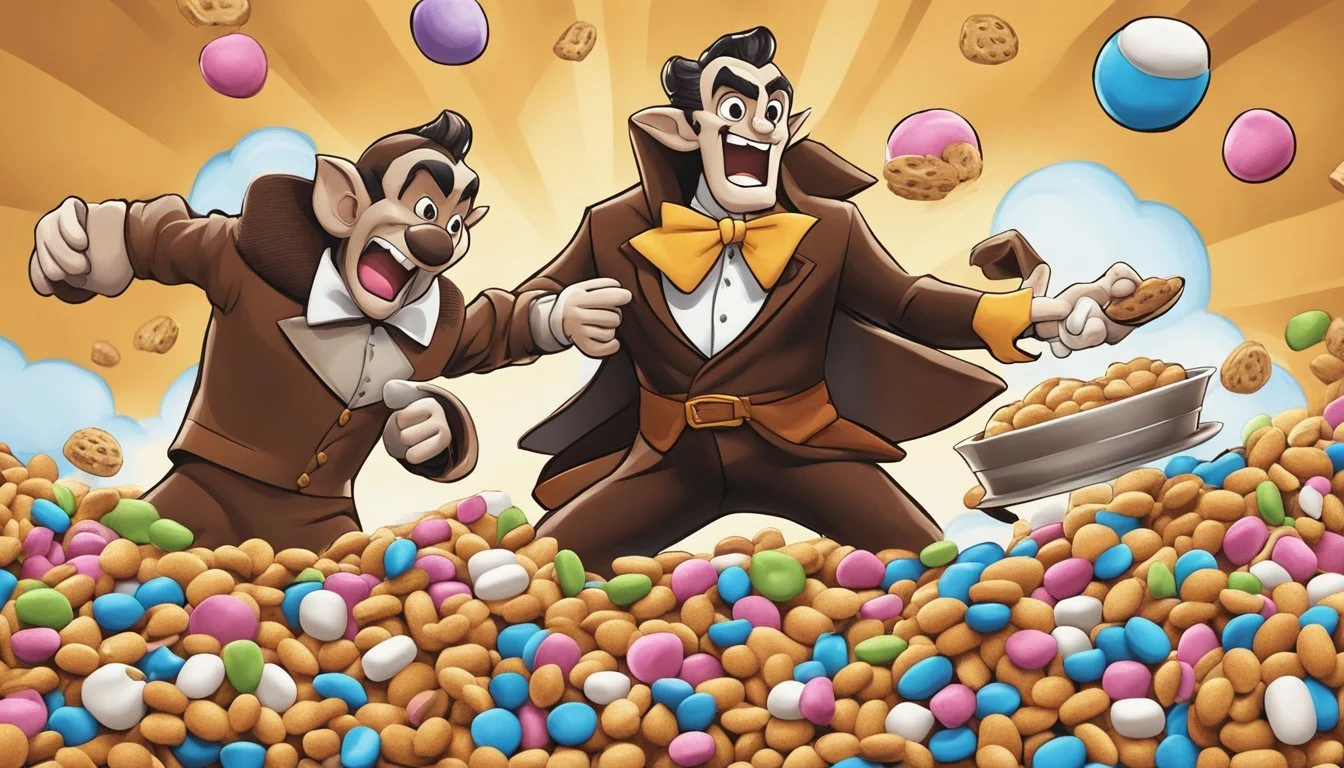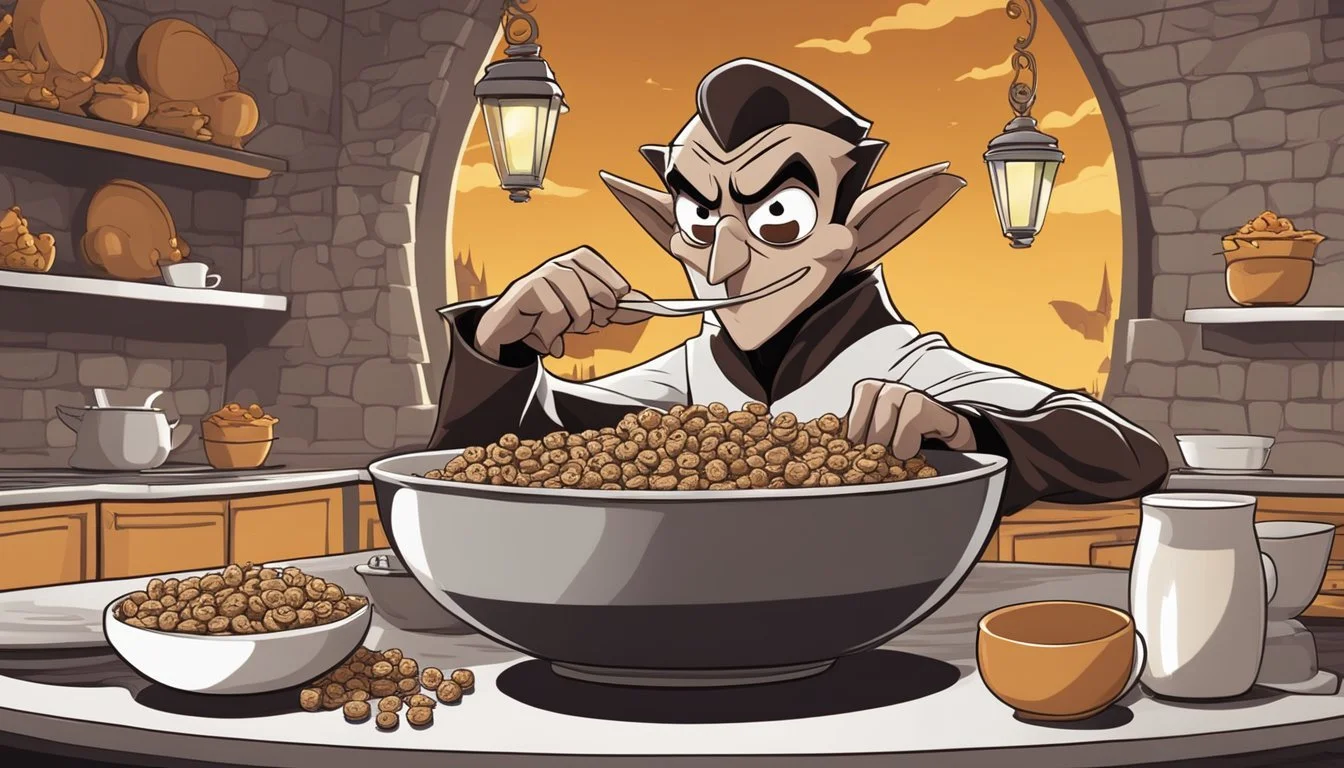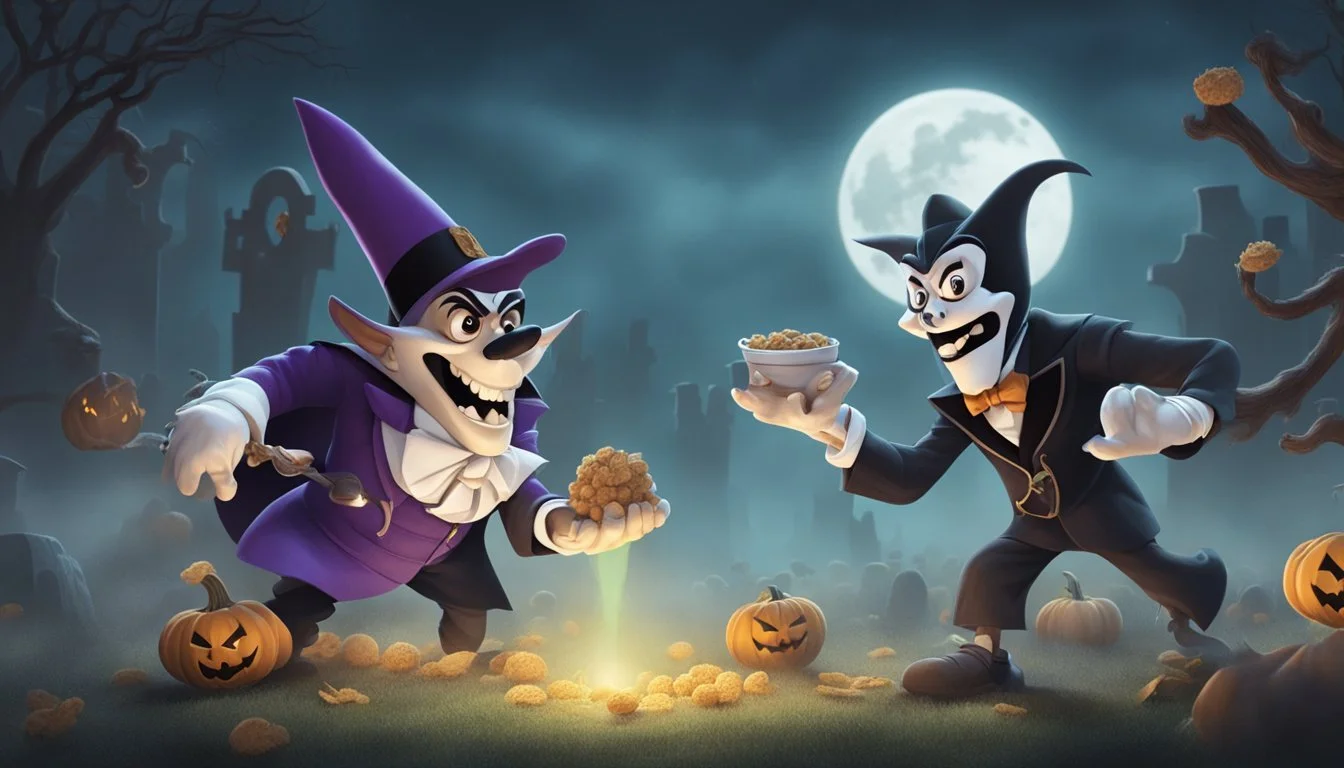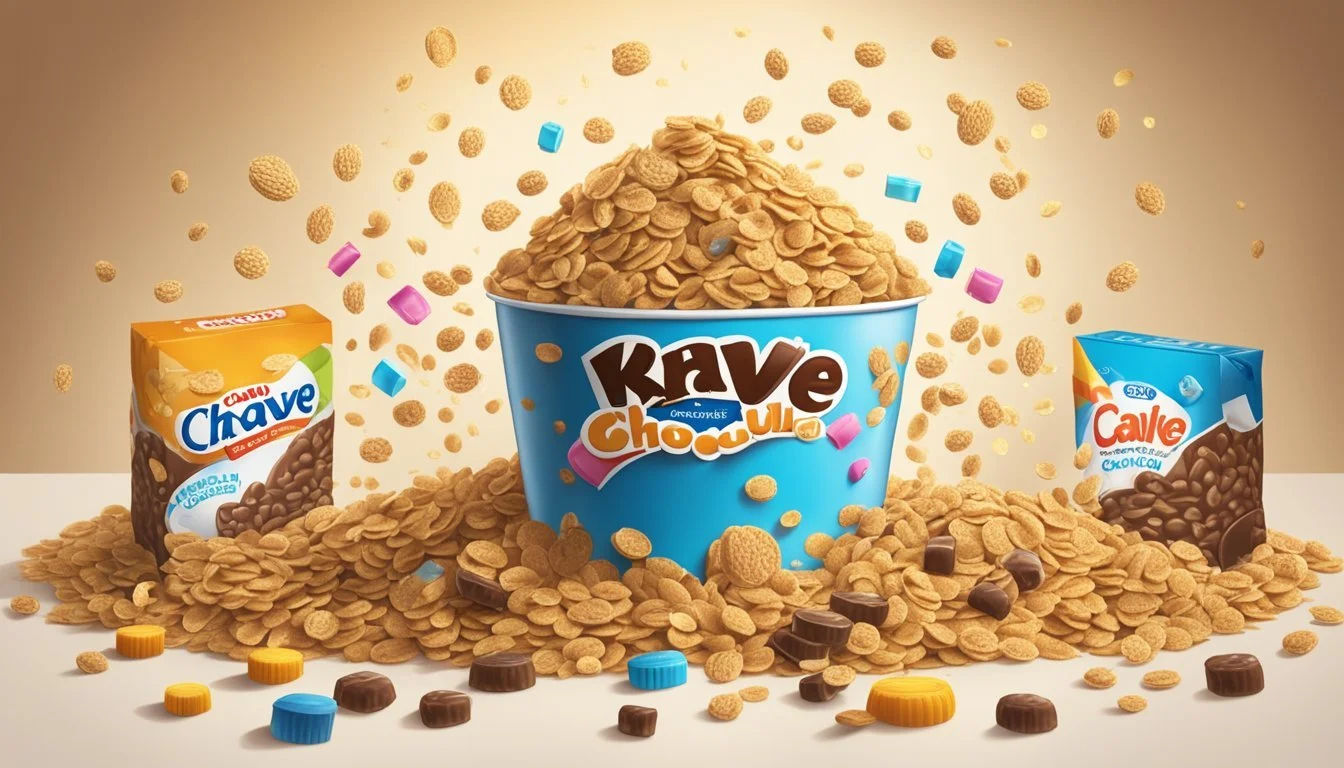Count Chocula vs Krave
Breakfast Cereal Showdown
This Article is Part of Our Breakfast Cereal Guide with Details on Count Chocula Nutrition and Krave Nutrition
In the world of breakfast cereals, two contenders often spark debate among chocolate lovers: Count Chocula and Krave. Both offer unique experiences to start your day. Count Chocula, with its spooky-themed packaging and blend of chocolatey cereal bites and marshmallow bits, has been a favorite since its debut in 1971. Its rich history and nostalgic appeal make it a beloved choice for many.
Krave, on the other hand, offers a modern twist with its crunchy, chocolate-filled cereal pieces. Designed to appeal to both kids and adults, Krave is praised for its rich, indulgent chocolate taste that doesn’t shy away from decadence. Unlike Count Chocula, which captures a playful, cartoonish essence, Krave is surprisingly good as both a cereal and a dry snack, making it a versatile option for those on the go.
In deciding between Count Chocula and Krave, it boils down to personal preference. Those who enjoy a rich, chocolatey breakfast with a spooky twist might lean towards Count Chocula. Meanwhile, those seeking a versatile, indulgent snack experience might prefer Krave. Both bring a unique charm to the breakfast table, ensuring a delightful start to any chocolate lover's day.
Background and History
Count Chocula and Krave represent iconic chocolate cereals, each with unique origins and paths to fame. Both products reshaped breakfast options and amassed loyal followings over time.
Origins of Count Chocula
Count Chocula was launched by General Mills in March 1971. Inspired by classic horror movie characters, the vampire-themed cereal aimed to stand out during the Halloween season.
Portrayed with cartoonish fangs and a playful grin, the chocolate-flavored cereal gained immediate popularity. The cereal's ads cleverly used technology to splice scenes from old horror films, further cementing Count Chocula's place in pop culture.
Count Chocula was not alone; it was part of a trio that included Franken Berry and Boo Berry. All three cereals became known for their themed flavors and seasonal releases, making them collectibles for avid fans.
Rise of Krave Cereal
Krave entered the breakfast cereal market much later, introduced by Kellogg's in 2012 in the United States. Krave offered a different approach to chocolate cereals, combining a crispy outer shell with a smooth chocolate filling.
This dual texture rapidly appealed to consumers looking for a novel breakfast experience. Krave positioned itself as indulgent yet convenient, capturing the interest of both traditional cereal lovers and newer audiences.
By emphasizing the contrast between crunchy and creamy textures, Krave managed to carve out its own niche on supermarket shelves, distinguishing itself from other chocolate-flavored options available.
Evolution of Breakfast Cereals
Breakfast cereals have seen significant changes since their inception. Initially, cereals like Corn Flakes were simple, unsweetened options aimed at promoting healthy eating. Over the decades, cereals evolved with increasing sugar content and diverse flavors to attract younger demographics.
The 1970s marked a boom with cereals like Count Chocula bolstering the trend of character-themed breakfast foods. These cereals weren't just for eating but were part of a larger marketing strategy that included toys, commercials, and memorable mascots.
Modern cereals like Krave reflect a shift towards indulgent, dessert-like experiences while balancing convenience and taste. Whether aiming for nostalgia or innovation, brands like General Mills and Kellogg's continue to redefine breakfast with new flavors and marketing tactics.
Cereal Characteristics
Count Chocula and Krave both offer unique experiences to cereal enthusiasts. Differences in ingredients, nutritional content, and the overall texture and taste lead to distinct breakfast options.
Ingredients and Nutritional Profile
Count Chocula features a notable combination of whole grain corn, sugar, and marshmallow bits. The cereal also includes corn syrup and dextrose, adding to its sweet profile. A 3/4 cup serving of Count Chocula contains:
Calories: 100
Total Fat: 1g
Saturated Fat: 0g
Cholesterol: 0mg
Sodium: 150mg
Total Carbohydrates: 22g
Dietary Fiber: 1g
Sugar: 9g
Protein: 1g
Krave from Kellogg's, on the other hand, focuses on delivering a more chocolatey experience. The ingredients include wheat flour, sugar, and cocoa processed with alkali. A 3/4 cup serving of Krave contains:
Calories: 180
Total Fat: 5g
Saturated Fat: 1g
Cholesterol: 0mg
Sodium: 150mg
Total Carbohydrates: 33g
Dietary Fiber: 2g
Sugar: 14g
Protein: 2g
Both cereals provide a sweet start to the day, though Krave has a higher calorie and sugar content.
Texture and Taste Experience
Count Chocula stands out with its crispy corn base and soft marshmallow bits. When combined with milk, the marshmallows become tender, enhancing the eating experience. The cereal retains a pleasant crunch, even after soaking in milk for a few minutes. The chocolate flavor is subtle but complemented by the sweetness of the marshmallows.
Krave offers a different texture, characterized by its crunchy outer shell and creamy chocolate filling. The crunch persists in milk, making for a satisfying bite. The chocolate filling provides an intense chocolatey taste, setting it apart from Count Chocula's mild flavor profile.
Each cereal caters to different preferences, with Count Chocula appealing to those who enjoy a mix of textures and Krave to those who prefer an indulgent chocolate experience.
Monster Cereals Legacy
The legacy of monster-themed cereals is rich with iconic characters and significant cultural impact. Their branding and collectible nature have made these cereals a perennial favorite.
Thematic Branding and Characters
General Mills introduced the Monster Cereals line in 1971, featuring Count Chocula, Franken Berry, and Boo Berry. The branding draws inspiration from classic horror films, using cartoon versions of monsters reminiscent of Bela Lugosi's Dracula. Over the years, limited-edition releases like Fruity Yummy Mummy and Fruit Brute have joined the lineup.
Each character has unique traits. Count Chocula claims bragging rights for chocolate-flavored cereal mixed with marshmallows. Franken Berry offers a strawberry variant, while Boo Berry provides a blueberry option. The characters’ personalities are showcased through commercials and packaging artwork.
Cultural Impact and Collectibility
Monster Cereals have transcended breakfast to become a cultural staple. They're often marketed seasonally, mostly from September to October, aligning with Halloween. This strategy enhances their timeless appeal.
The limited-edition nature of some cereals has created a collector's market, with enthusiasts seeking vintage packaging and promotional items on platforms like eBay. Moreover, the characters have appeared in numerous media settings, embedding themselves into Hollywood culture. Their vintage art and commercial spots have even inspired modern redesigns to preserve the nostalgic charm.
The interplay between General Mills Monster Cereals and pop culture ensures that these products continue to be beloved by both children and adults alike.
Marketing and Design
Count Chocula and Krave have distinctive approaches to marketing and design, centered around their unique mascots and packaging evolution. They also employ varied advertising strategies, leveraging different media to attract consumers.
Packaging and Mascot Evolution
Count Chocula, introduced in 1971, features a vampire mascot inspired by Count Dracula. Over the decades, Count Chocula's design has seen numerous changes, evolving from a more sinister vampire to a friendly, cartoonish character with chocolate-themed elements.
The packaging initially emphasized a gothic horror aesthetic, common in the early monster cereal designs, but now integrates brighter colors and playful imagery to appeal to younger audiences. Collaborations with artists like KAWS have also refreshed the brand, adding modern flair and collectible box designs.
Krave, a relatively newer cereal, introduced in 2012, employs a different strategy. Its mascot—a piece of chocolate-filled cereal with eyes—focuses on the indulgence and crave-worthy aspect. The packaging is minimalist, highlighting the cereal's chocolatey attributes. Simple but bold color schemes dominate the box, making it stand out on grocery shelves.
Advertising Campaigns
Count Chocula's advertising has a rich history of engaging animated commercials often aired during Saturday morning cartoons. These commercials frequently featured Count Chocula alongside fellow monster cereals like Franken Berry, emphasizing the fun and spooky nature of the brand. Tony the Tiger, another iconic cereal mascot, often shared commercial slots, creating a nostalgic connection for viewers.
Marketing has evolved to include digital campaigns and social media collaborations, involving influencers and artists like Laura Levine to attract younger audiences. Special seasonal releases during Halloween also enhance its appeal.
Krave's advertising is contemporary, focusing on digital platforms and targeted advertisements. Campaigns emphasize the indulgent, chocolatey experience and often feature playful, humorous content designed to appeal to older children and teenagers. The brand highlights the sensory pleasure of eating Krave, creating a strong desire for the product.
Consumer Reception and Trends
Count Chocula and Krave have both built distinct niches within the cereal market, driven by seasonal popularity and dedicated fan communities. Each brand employs unique strategies to engage consumers and boost sales.
Sales Performance and Seasonality
Count Chocula experiences a significant surge during the fall season, particularly around Halloween. Its reintroduction alongside other Monster Cereals like Franken Berry and Boo Berry contributes to its seasonal appeal. Limited-time offerings and special packaging by artists like KAWS add to its allure.
In contrast, Krave maintains steady sales year-round without heavy reliance on seasonal trends. This consistency is backed by its broad flavor variations and stable market presence. Sales data indicate that it appeals to a different consumer segment, focusing on chocolate lovers who seek an everyday indulgence.
Fan Interactions and Community
Count Chocula's fanbase is highly engaged, often participating in Halloween-themed events and online communities. Reviews frequently highlight nostalgia and brand loyalty. Sweepstakes and promotions further amplify engagement, making it a favorite for collectors and fans of retro cereals.
Krave, while not having the same cult-like following, boasts a strong base of chocolate enthusiasts. Reviews typically emphasize the cereal's crunch and rich flavor. Social media interactions highlight its versatility in recipes, indicating a more modern, lifestyle-oriented community.
Flavor Variants and Comparisons
Count Chocula and Krave each bring unique chocolate experiences to the breakfast table. This section breaks down the main flavor options and taste characteristics of both cereals.
Count Chocula's Flavor Range
Count Chocula is a beloved chocolate-flavored cereal known for its rich chocolatey taste and whimsical vampire mascot. It features chocolate corn cereal pieces mixed with colorful marshmallow bits. The unique combination of chocolate and marshmallow appeals to those looking for a sweet, nostalgic breakfast option.
Flavor Composition:
Main Flavor: Chocolate
Add-ons: Marshmallow bits (varied colors)
Despite its strong chocolate flavor, Count Chocula maintains a light texture that blends well with milk, creating a deliciously creamy chocolate milk as you eat. This chocolate-marshmallow blend sets it apart from other chocolate cereals on the market.
Krave's Taste Profile
Krave offers a distinct chocolate experience with its crispy cereal shells filled with creamy chocolate. The cereal’s dual-texture approach provides a crunchy exterior and a smooth, almost dessert-like chocolate interior.
Flavor Composition:
Main Flavor: Chocolate filling
Texture: Crunchy exterior, creamy filling
Krave’s appeal lies in its combination of textures and the quality of its chocolate filling. Unlike Count Chocula, which mixes marshmallows, Krave focuses entirely on delivering an indulgent chocolate experience. With flavors like Double Chocolate and Chocolate Chip Cookie Dough, Krave caters to those seeking a richer, more intense chocolate taste.
These distinctive approaches to chocolate flavor make both cereals unique in their own right, offering varied options for chocolate lovers looking for a specific kind of breakfast treat.
Nutritional Analysis and Health Discussion
Both Count Chocula and Krave offer unique flavors but come with considerable amounts of sugar. Below, we explore the health concerns related to their sugar content and their potential roles in a balanced diet.
Health Concerns Related to Sugar
Count Chocula contains approximately 103.4 calories per serving, with added sugars being a significant portion of this energy. Krave chocolate cereal, on the other hand, delivers around 210 calories per serving with a similar emphasis on sugary content.
High sugar intake can lead to various health issues including obesity, type 2 diabetes, and dental problems. It's essential for consumers to monitor their daily sugar consumption. The FDA recommends a daily value of no more than 50 grams of added sugar, but stricter guidelines suggest limiting it to 25 grams for women and 37 grams for men.
Overeating sugared cereals like these can quickly push sugar intake beyond healthy limits.
Role in a Balanced Diet
Both cereals offer some nutritional value beyond sugar. Count Chocula provides around 1.3 grams of total fat and proteins that can contribute to daily dietary needs. Krave contains 6 grams of total fat per serving and provides more substantial calorie content.
When integrating either cereal into a balanced diet, it's crucial to consider their sugary nature. They can be paired with foods high in protein and fiber to create a more balanced meal. Including fruits, nuts, or yogurt can help balance the high sugar and carbohydrate content.
Limiting portion sizes and not making them a daily staple ensures they fit within a healthy dietary pattern.
Fat and sodium content in both cereals also warrant moderation.
Comparative Market Analysis
Count Chocula and Krave occupy unique positions within the breakfast cereal market, each appealing to distinct audience segments. This section examines their market share, competition, and alignment with current trends.
Count Chocula in the Competitive Landscape
Count Chocula, a classic chocolate-flavored cereal with marshmallows, has a nostalgic appeal. Originating in the 1970s, it primarily targets older generations who have childhood memories of the brand.
Count Chocula's market presence has waned over the years, but it continues to enjoy seasonal resurgences, especially during Halloween. The cereal faces stiff competition from newer chocolate-based cereals and more health-conscious options.
Nevertheless, its unique branding and loyal customer base keep it relevant in a crowded marketplace. Count Chocula's consistency and recognizable mascot contribute to its enduring presence.
Krave's Place in Modern Cereal Offerings
Krave is relatively new, launched to cater to millennials and younger consumers. Its chocolate-filled pillows offer a unique twist that differentiates it from traditional cereals.
Krave capitalizes on modern market trends emphasizing indulgence and innovative flavors. It competes directly with both classic cereals and snack-oriented breakfast options like granola bars.
Krave's market share has grown steadily, thanks to aggressive marketing and favorable consumer reviews. Its appeal to individuals seeking a balance between taste and convenience has positioned it well within the competitive landscape of modern cereal offerings.










